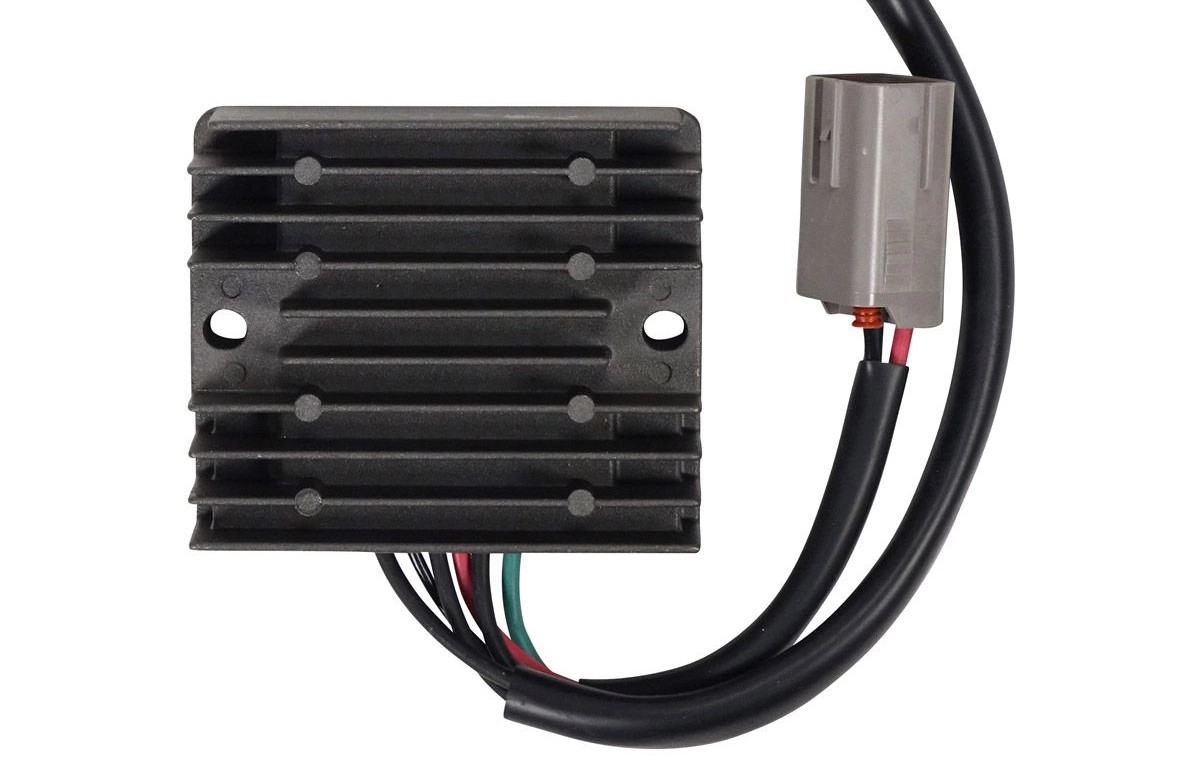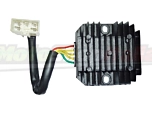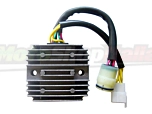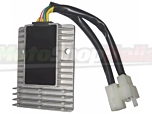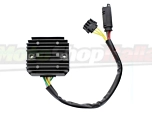In this article, we'll discuss voltage regulators.
The voltage regulator is a crucial component in motorcycles and scooters. It ensures electrical stability, essential for optimal vehicle operation. Think of the regulator as a vigilant guardian: it monitors and adjusts electrical voltage. This process protects the motorcycle's battery and electronic circuits.
The main role of the regulator is to maintain constant voltage. Without it, voltage fluctuations could seriously damage the motorcycle. For example, too high a voltage can overcharge the battery. Conversely, too low a voltage does not charge it adequately. The regulator intervenes, ensuring that the voltage stays within safe limits.
In newer vehicles, for instance, it contributes to energy efficiency and emission reduction. In some motorcycles, the regulator helps manage advanced systems like LED lighting and navigation systems.
Imagine a situation: you're traveling on a mountain road. The motorcycle needs constant energy for lights, indicators, and the engine itself. The regulator works behind the scenes, ensuring that each component receives the right voltage. This not only improves performance but also safety.
Thus, the voltage regulator in motorcycles or scooters is not just a component. It is a guarantee of reliability and safety. With its presence, we can enjoy worry-free journeys, knowing that the electrical part of our motorcycle is in good hands. Its role is constantly evolving, adapting to new technologies and enhancing the driving experience. In this rapidly evolving technological world, the voltage regulator remains an essential part of the puzzle, crucial for our connection with the road.
What happens if the voltage regulator in the motorcycle or scooter does not function correctly?
When the voltage regulator of your motorcycle or scooter has problems, you can face undesirable situations: if the voltage rises too much, the electronic components risk overheating. This can damage vital parts like the alternator and the ignition system. Moreover, excessive voltage can increase fuel consumption, negatively affecting engine performance.
Conversely, too low a voltage is no less problematic. In this case, the engine loses efficiency, and the motorcycle might even suddenly shut down. The battery also suffers, discharging quickly and requiring frequent recharges. And that's not all: a faulty regulator can overheat the alternator, leading to further damage.
The signs of a faulty voltage regulator are quite clear. If the bulbs burn out often, it's an early warning sign. If the instrument panel shuts off without reason or the battery seems not to hold a charge, these are signs not to be underestimated. Excessive consumption of the battery's electrolyte is also an indicator of a problem. If the motorcycle does not maintain idle or has difficulty starting, it's time for a check-up.
A voltage regulator that does not function properly should be checked and, if necessary, replaced. This step is crucial to avoid greater problems and ensure safe and trouble-free trips.
Advantages of using voltage regulators in motorcycles
Voltage regulators play a key role in motorcycles, protecting electronic components and optimizing energy use. These small devices have a significant impact on the performance and longevity of the vehicle.
Below we include the main advantages of voltage regulators:
- Protection of components: the motorcycle is full of delicate electronic parts. The voltage regulator takes care of these, preventing overvoltages or sudden drops from damaging crucial systems like the ignition or display.
- Greater energy efficiency: in addition to protection, regulators also help reduce energy wastage. This translates into a longer-lasting battery and lower fuel consumption. When traveling, the regulator modulates the necessary energy based on driving conditions, ensuring no waste.
- Extension of lifespan: an often overlooked aspect is how much regulators contribute to the longevity of the motorcycle. By maintaining stable voltage, they reduce the wear and tear of electronic components. This means fewer visits to the mechanic and more time on the road.
In short, voltage regulators are indispensable for keeping your motorcycle in top shape. They not only ensure that electronic systems function correctly but also contribute to a more efficient and enjoyable driving experience. A small device, great benefits: this is the true value of voltage regulators in motorcycles.
Installation and Maintenance of Voltage Regulators in Motorcycles
The installation and maintenance of voltage regulators are crucial steps to ensure the proper functioning of your motorcycle. It's important to follow some basic procedures and adopt regular maintenance practices.
Basic Installation Procedures: Installing a voltage regulator isn't complicated, but it does require attention. First and foremost, disconnect the battery. This prevents short circuits and damage. Locate the old regulator and remove it gently. Be careful with connections: every cable must go in the right place. When installing the new regulator, make sure it's securely fastened and the connections are tight.
Practical Example: Think of changing a light bulb. Even if you're not an electrician, with the right instructions and a bit of caution, you can do it. The same applies to the installation of the regulator. Follow the instructions, proceed calmly, and your motorcycle will be ready for the road.
Maintenance Tips: Regular maintenance of the voltage regulator is essential for the longevity of the motorcycle. Periodically check the connections to ensure they are clean and not oxidized. Also, observe the regulator for signs of overheating or damage. If you notice anything unusual, it's better to consult a technician.
Safety First: When working on the regulator, safety is paramount. Always use the appropriate tools and wear protective gloves. If you're unsure about how to proceed, seek help from a professional. Remember, it's better to be cautious than to risk damage to the motorcycle or yourself.
Innovations and Future Trends in Voltage Regulators for Motorcycles
There are numerous innovations in the field of motorcycle voltage regulators. There are always advances aimed at improving safety, energy efficiency, and driving experience.
Energy Efficiency and Electric Motors: With the increasing use of electric motors in motorcycles, energy efficiency is becoming a key factor. These motors, in addition to reducing environmental impact, offer lower consumption costs and require less maintenance while maintaining high capacity even after prolonged use.
Advanced Safety Systems: The motorcycle industry is investing significantly in safety. For example, KTM has developed systems like Adaptive Cruise Control (ACC) and Blind Spot Detection (BSD), which use advanced sensors to prevent collisions and improve driver safety.
Helmets with Augmented Reality: Helmets are becoming high-tech devices. The Jarvish X AR, for instance, incorporates augmented reality and a Head-Up Display to provide the rider with information on speed, navigation, and a 360° view without taking their eyes off the road. These helmets also use voice commands and are connected to systems like Alexa.
These trends highlight a strong emphasis on innovations that not only improve the riding experience but also place a significant focus on safety and energy efficiency. These developments could have a significant impact on the future design of voltage regulators, aiming to support these advanced technologies.
Conclusions and Final Considerations
In concluding this article, we can state: it is clear that voltage regulators play a fundamental role in the health and efficiency of motorcycles. They have the crucial task of protecting delicate electrical circuits and improving energy efficiency. From their ability to adapt to various driving conditions, to the protection they offer against damage due to overvoltages, voltage regulators are indispensable for a safe and enjoyable ride.
Remember the key points of the article: voltage regulators not only preserve the life of the motorcycle's electronic components but also contribute to a smoother driving experience and reduced consumption. Innovations in the field are leading to increasingly efficient and adaptable regulators.
If you are interested in updating or replacing the voltage regulator of your motorcycle, check out the products in our store. You'll find a wide range of voltage regulators, suitable for different needs and models of motorcycles or scooters.

 Italiano
Italiano
